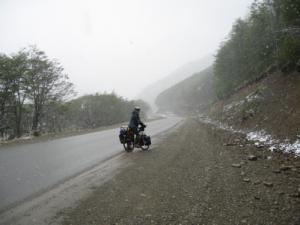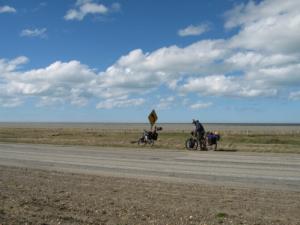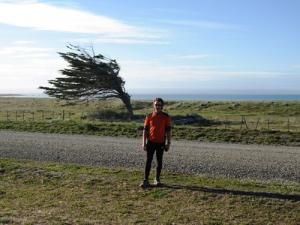It pays to research things thoroughly when you’re planning an adventure on a bicycle in one of the most remote regions on the planet. Otherwise, you might find yourself attempting the "impossible". The first part of our trip was in the southernmost territory of Patagonia, Tierra del Fuego (Land of the Fire). The name comes from the explorer, Magellan, who mistook the natural fires he could see from his ship as Indians on the shores waiting to ambush him. Even so, Tierra del Viento (Land of the Wind) would be more appropriate. The wind was a phenomenal force to be reckoned with.
A phenomenal force
My partner, Mick. and I started the ride in early November from the city of Ushuaia, on the southern tip of South America. We’d decided on a date and promised the night before, we’d leave – rain, hail or shine. I woke feeling excited (if slightly hung over after poker and drinks at the hostelry until 3:00 a.m.) only to look outside and see it was bucketing with snow. My mutterings that there was no snow the previous night didn’t sway Mick in the least. We’d never done anything more than an overnight trip on the bikes before, deciding we’d attempt to ride from Ushuaia to Mendoza, up the spine of the Andes. I wasn’t sure if I’d be up to the task.

We got on the bikes anyway, trying to ignore the concerned looks and half-smothered grins of the hostelry staff and backpackers who, I suspect, thought they’d see us again soon. It was beautiful riding for the first 25 kilometers, as we wound our way up into the mountains through the snow with a nice tailwind pushing us along. It was easy to ignore the fact that I was becoming soaked from the huge, wet flakes as I pumped the pedals energetically. Eventually the snow stopped and the weather warmed up, while the scenery became more spectacular; jagged snowy mountains in every direction and long tongues of glaciers winding down their sides. We reached the top of a pass; the other side opened into a long view of rolling hills, huge sparkling blue lakes and sunshine. We whizzed down the other side and made camp by a bridge on a pretty little river. Our peaceful camp was only punctuated by the sound of every car, bus or truck honking hello to us as they went over the bridge.
The first days of riding were great – the wind was at our backs, the scenery was varied with the mountains always in sight in the distance, and we found great bush camping spots. It was amazing to look behind and think that I’d pedaled all the way from those distant mountains already – anything seemed possible; my doubts were starting to be dispelled for good. I couldn’t help feeling a bit like a celebrity; in those parts almost everyone honked or waved encouragement as they passed. It did get a bit weird though, when people started taking photos of us; I thought we were the tourists!
Then we hit the wind. Or rather, it hit us, like with a sledgehammer. At first we could still ride, swerving all over the road. It was fun in the first few hours, finding the wind shadow behind Mick for the one kilometer "rest" I would have before swapping back to the front for my turn, if I ignored the fact that we were only travelling at little more than walking speed. Then it got really angry and we were off the bikes, pushing them with our heads down against the wind. Sand blasted into our jackets burning any exposed flesh. All I could hear was the rapid flapping of my windproof jacket hood next to my ears and the screaming of the wind. At times we were forced to a complete halt while we struggled to remain upright. Fierce crosswinds threatened to rip the bike from my hands. Most heartbreaking of all, we came to a large downhill section of road, at least two kilometers on a pretty steep gradient; we had to keep pushing (really pushing!) our bikes all the way down the hill.

Three times vehicles stopped in front of us and asked if we wanted a ride. They were incredulous. “What were we crazy people doing? Obviously we were being stupid pushing the bikes when they could get us to Rio Grande in half an hour”. One guy didn’t even ask – he just stopped his old pickup truck, came around to my side and started loading my stuff into the back without saying a word. I think he was a bit put out when I politely refused, screaming “no gracias” into the wind. We could hardy give up now, not on the third day out!
After pushing the bikes for about 20 kilometers into the icy wind, we had had it, plus it was almost the end of the day. We were 30 kilometers from Rio Grande, a distance that should have been an easy ride from our last camp. Now, though, it was 7:00 p.m., even with the extra long Patagonian summer days. We were never going to make it. After spotting an unlocked gate and a patch of rare trees on the leeward side of a hill that looked like they might offer some shelter, we made camp. All day, water had been scarce; we were forced to make do with a smelly, dirty swamp. Thank god for the water filter. The wind calmed down overnight; we breathed a great sigh of relief. Ah, If only we’d known, we would have gotten up in the middle of the night and continued riding.
The wind started up again at about 7:00 a.m. We couldn’t beat it out of bed. We only had to push the bikes for some of the time, though – I wasn’t sure if the wind was a little weaker or we were getting better at staying on the bikes! The last 10 kilometers into Rio Grande was a treat – the road turned east and we got some of that wind at our backs. How friendly it suddenly seemed, like a nice hand on the back pushing faster and faster.
We took an unplanned rest day in the town of Rio Grande. We were exhausted. It was not the prettiest town in Argentina, made worse by the fact that the wind howled through the streets day and night. It was common to see people knocked clean over, while standing in line for the bank. Mothers clutched their children as they walked, probably fearful they’d get blown onto the road rather than run onto it. We had learned by now that the wind was normal for this time of year, that it was usually this windy from October to April, meaning the only time it stopped was in winter, when it's cold and dark. No wonder the mood of the town seemed a touch depressing.
The redeeming quality of Rio Grande was the wonderful hospitality we received at the Hostel Argentino. The lovely owner, Graciela, felt so badly that she couldn’t offer us a bed to sleep in that she gave us a mattress to put in our tent and let us camp in the backyard. Truly heavenly. We also met another bike tourist, Hirsch, who had cycled all the way from Vanuatu via Vancouver, down through the western part of the Americas. He went out of his way to help us. Although we only spent a little time with him, he gave us the inspiration we needed in the coming days with words like, “Don’t worry guys, the wind will stop or be at your back eventually, don’t give up yet”. We needed it.
The wind didn’t seem to be abating, but we decided to press on anyway, after the rest day. Graciela checked the weather from her meteorologist friend before we left; only 60 kilometer per hour gusting to 80 – totally ride-able! We didn’t leave until afternoon so we made camp 25 kilometers up the road, under a bridge, which gave very poor shelter from the howling. Still, it was something. Our spirits improved the next morning when the winds eased. Unfortunately, it didn’t last past 9:00 a.m. We were forced to take shelter in a table drain by the side of the road for a couple of hours' nap to gather more strength to reach the Argentine border station at San Sebastian.
A few kilometers from the town, we encountered an intense rainstorm (we would have hardly noticed the difference, but for the stinging). Inevitably, after a huge gust that caught me off guard, I found myself face down on the gravel at the side of the road. Amazingly, my bike lay about three meters clear. I had literally been blown off my bike. It was the last straw of a tough day; I felt entitled to a short (but sweet) bawl. Finally, we staggered into the little inn which had a ton of space and rooms going for cheap. The semi hot shower felt luxurious, as was a bed after more than a week in the tent.

It continued to blow a gale as we crossed the border into Chile the next morning under sunny skies. It was time to ask ourselves some tough questions. We were going directly into the wind; we were both getting extremely tired. It would take four days at the present rate to get to the next town, Porvenir. We knew we weren’t really up to struggling the entire way, our knees were already painful, and we didn’t want to have to quit the rest of the ride because of injury. We decided to hitch a lift if the wind didn’t calm down the next day.
Providence eased the wind; by the afternoon it was a gentle breeze. We were off the main road, away from the traffic, on a little gravelly but well-maintained road. We relaxed and started to enjoy things. We rode over sparsely vegetated rolling hills filled with a million sheep – the "real" Patagonia. Wildflowers covered the ground and small lakes with pink flamingos. Strutting around them were scattered depressions of the landscape. Our luck improved when we discovered little shelters every ten to twenty kilometers along the deserted road, which offered wind protection, a roof and sometimes a small wood heating stove. Their purpose was for the use of gauchos herding sheep along the road, and weary bike tourists too! We were grateful to settle down early, pitching the tent out the front of one of the shelters.

Hirsch’s words of wisdom were spot on. Our luck changed for the better. We woke up the next day and there was a slight breeze – from the east! I couldn’t believe it. I thought the wind was nearly always from the west here (directly in our faces). What a good surprise! We had a great time riding that day. Guanacos, wild llamas, stared us down from the roadside; sheep ran from the fences as we whizzed by. The scenery got even better, especially as we reached the coast. We rode along a big bay where dolphins swam parallel to us. They were about 50 meters out to sea. We were now riding 110 kilometers per day, compared with 60 to 80 previously – and that on a gravel road right to Porvenir (a broken pedal for the last 20 kilometers couldn’t even stop me). That sort of riding was what we had been waiting for, what we had kept going for – spectacular.
We had completed 460 kilometers when we arrived in Porvenir. It felt like more. Later in our bike trip, we found information in a guidebook that said it was "impossible" to ride a bike in Tierra del Fuego due to the wind. We know that’s not true. But it sure was a good fight. We won.